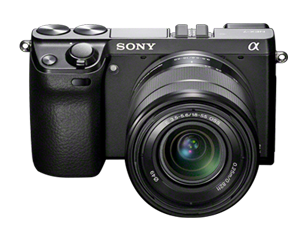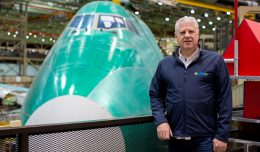What of this new buzz in the photography world regarding the mirror in a dSLR? It seems like everyone is making a mad rush to this new world of cameras without mirrors. Well, let’s hold on a sec. Cameras without mirrors have been around since way before digital cameras. Point and Shoot cameras have never had mirrors in them, nor did Rangefinders or View Cameras. So why all the fuss?

Sony Alpha A77
The mirror in the SLR (and consequently the Digital SLR or dSLR) comes from the need to have a realistic view of the scene being photographed. SLR stands for Single Lens Reflex and it essentially works by placing a mirror at a 45 degree angle in the path of the light that would otherwise strike the film plane or imaging sensor in a digital camera. This is done so the photographer can see exactly what the film or sensor will see. While it may not be that important when taking family snapshots, it is critically important the more you want your image to be as close to what you envisioned as possible. Something a rangefinder can approximate but never perfectly accomplish.
Recently, camera manufacturers have begun to ship cameras that are lacking a reflex mirror. However these are not to be confused with point and shoot cameras that have never had a mirror. Instead the move seems to be towards professional or semi-professional cameras and systems that lack the complexity and bulk/size/weight of a traditional SLR design. These new cameras and systems are using pro technology and features found on much higher priced advanced amateur, semi-pro and professional cameras. The big camera manufacturers like Sony and Nikon have developed entirely new systems and lenses such as the Nikon 1 and Sony NEX. Canon has still to chime in with a response but surely will.
Advantages
The advantages of removing the mirror are simple to understand.
Weight and Bulk
By reducing the components needed to operate the mirror mechanism, camera bodies can be made much slimmer and weight is reduced as a result.
Reliability
By having a lot fewer moving parts, the lifespan of the camera is potentially far greater, although advances in technology will take care of you wanting to keep a camera longer than the next hot ticket.
Speed
By having no mechanical mirror, there is a greater potential for much faster operation as there are fewer moving parts to move in and out of the field of view.
Disadvantages
All of the new mirrorless cameras are far slimmer than a typical dSLR. Since there is no mirror, the sensor can be placed much closer to the rear element of the lens. However, this introduces other challenges such as lens design and even sensor design. The angle at which the light must fall on to a sensor is much more acute and thereby can introduce light falloff as light does not reach the far corners of the sensor with the same intensity as that falling on the center of the sensor.

Sony NEX
Another potential disadvantage some may feel is an advantage is that of a smaller camera. I have big hands and I like a bulky camera. I am quite uncomfortable holding a small point and shoot. However, hiking up AXALP Mountain for two hours to see an airshow with 75 pounds of gear is no fun. Weight savings is nothing to discount.
To me the worst offender is the lack of the mirror itself. In order to give you the same view you had with the mirror, most new mirrorless systems use some form of electronic viewfinder or EVF. Yes, they are super high resolution, very fast and can offer lots more features than a traditional mirror/pentaprism design of old, but they are still not real life or real time like a mirror. This will undoubtedly improve to the point we take it for granted, but for now, I am sticking to my SLR.
Finally, the sensors themselves. So far, Sony and Nikon have used smaller than full size 35mm sensors. Leica has a full frame sensor in their mirrorless camera but that is an expensive camera. A smaller sensor will undoubtedly produce noisier images and with a move to greater and greater resolution, packing more pixels into an already small area will only make things worse.
The Future
I am hopeful and optimistic. We may find that a combination of a traditional dSLR design with no mirror and good electronic viewfinders, full frame sensors and ever improving technology, the mirror will see a future similar to film.
How It All Relates to Aviation Photography
This can probably fill a book. The choice will come down to the photographer, the intended result and the available best tool for the job. I do believe the technology will improve rather quickly and the shortcomings of a mirrorless design will fade. However my opinion is that a hybrid will be the only thing that will satisfy the pros. Having a full frame sensor offers tremendous creative flexibility which would be impossible for a physically smaller sensor and lenses to offer. Depth of Field is of greatest consequence.

Nikon V1
In aviation photography, the greatest percentages of photos are those of an aircraft at a large distance and shallow DoF is rarely a desire. Most aviation photographers will love the idea of a smaller camera/lens and much faster performance with deep buffers to do their bidding. But lack of a real life view through the viewfinder via a traditional mirror replaced by slow or laggy LCD displays will not be a good thing. I am certain this challenge will be met within the next few years or sooner.
A Good Compromise
Currently, the Sony Alpha A77 is a great window into the future. It is a hybrid camera design using a fixed mirror instead of a flip/up design or no mirror at all. This camera’s mirror is semi-transparent giving sort of the best of both worlds. However, it still uses an EVF instead of a Pentaprism to convey the scene to the photographer. It is a terrific implementation but a bit laggy which means you may clip a nose or a tail in a high speed pass at an airshow. But it is very promising. Sony isn’t the first to implement this design with Canon having had a similar system in an older Pro model.
Conclusion
While I am personally not yet sold on the current breed of mirrorless cameras, I do believe there is a future where the traditional dSLR mirror flap will be gone forever. Next to go is that pesky mechanical shutter!






